There are over 6,000 species of crab inhabiting the world. Crabs are decapods, which also include lobsters, shrimps, and prawns. These invertebrates belong to the family Brachyura and are covered in a hard shell to protect their body. Crabs also have ten legs and two claws. They also occupy a wide range of habitats and may be terrestrial or water-dwelling. They are eaten by various aquatic life and enjoyed as a delicacy in many cultures.
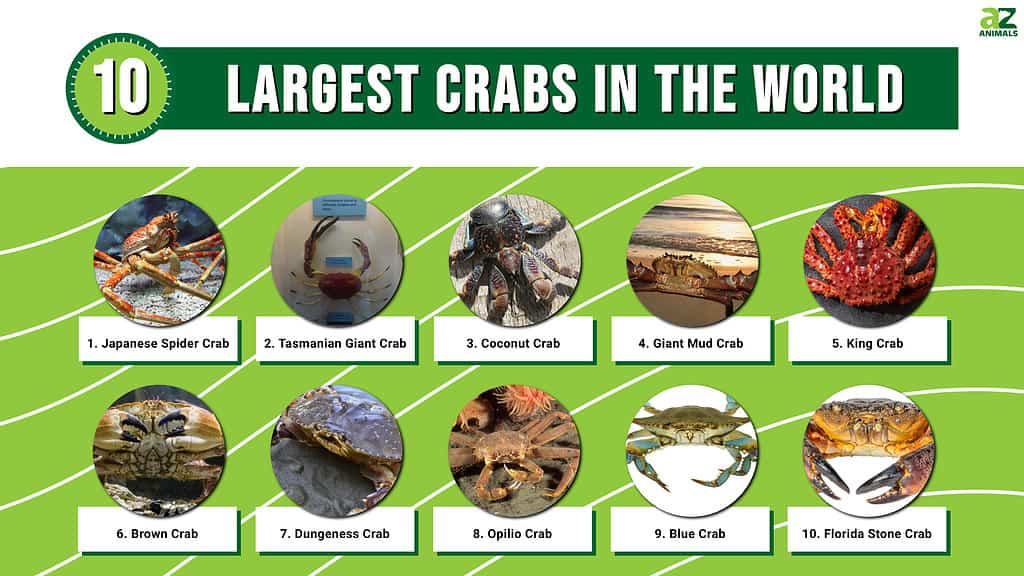
On this list, we will take a look at ten of the largest species of crab in the world. The size of each crab varies and some can grow to be unusually large. The crabs on this list are ranked by what species gets the largest, based on their carapace width and mass. Let’s take a look at the ten largest crabs in the world.
#10: Florida Stone Crab

Colorful
stone
crab isolated on white background.
©Process/Shutterstock.com
The Florida stone crab (Menippe mercenaria) is one of the most expensive species in the world and only their claws are eaten. Their carapace is 5 to 6.5 inches, but their claws are large and harvested for eating. Females are larger than males but males generally have larger claws. The stone crabs’ claws can reach up to 5 inches. These crabs are captured and then released back into the ocean after their claws are harvested.
Stones crabs can be found in the western North Atlantic Ocean. In South Carolina and Georgia, they inhabit salt marshes. They dig holes 6 inches to 3 feet deep near semi-shallow water. Along with humans, other predators included turtles, octopi, and cobia.
#9: Blue Crab
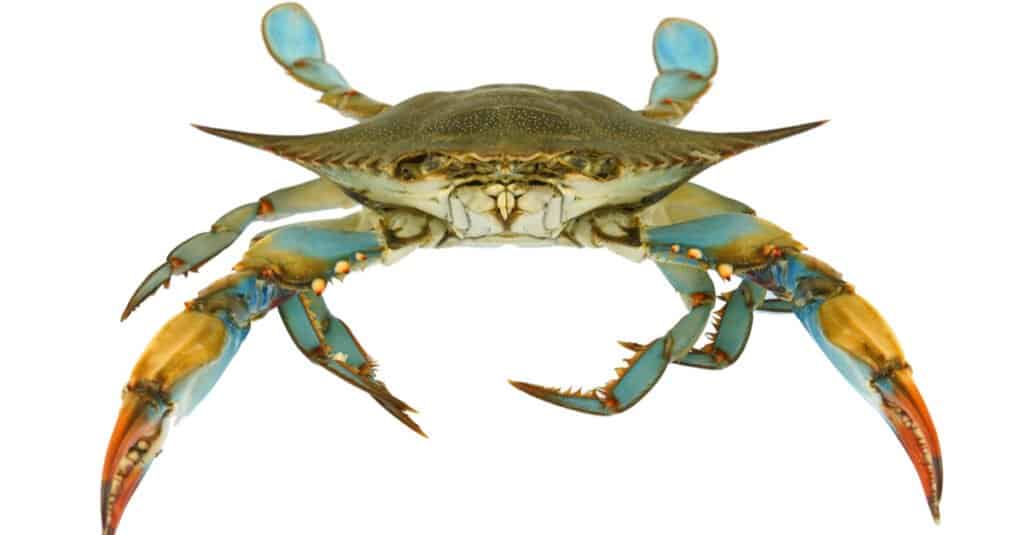
The blue crab has a wide carapace but only weighs around one pound
©ND700/Shutterstock.com
Blue crabs (Callinectes sapidus) are also called the Atlantic blue crab, and the Chesapeake blue crab. They are olive green and mostly known for their bright blue claws. This species can reach up to 9 inches but will only weigh up to 1 lb. Found in the Atlantic Ocean and throughout the Gulf of Mexico, this species is widespread and has been introduced to other parts of the world for its meat.
Blue crabs feed on clams, oysters small fish, and decaying animals. With a lifespan of three years, they spend their time in shallow waters. In winter they bury themselves to survive the colder temperatures. Blue crabs handle global warming better than other species as they thrive in warmer temperatures. Scientists estimate that the rate at which this crustacean species will survive oncoming winters is set to increase by 20%.
#8: Opilio Crab
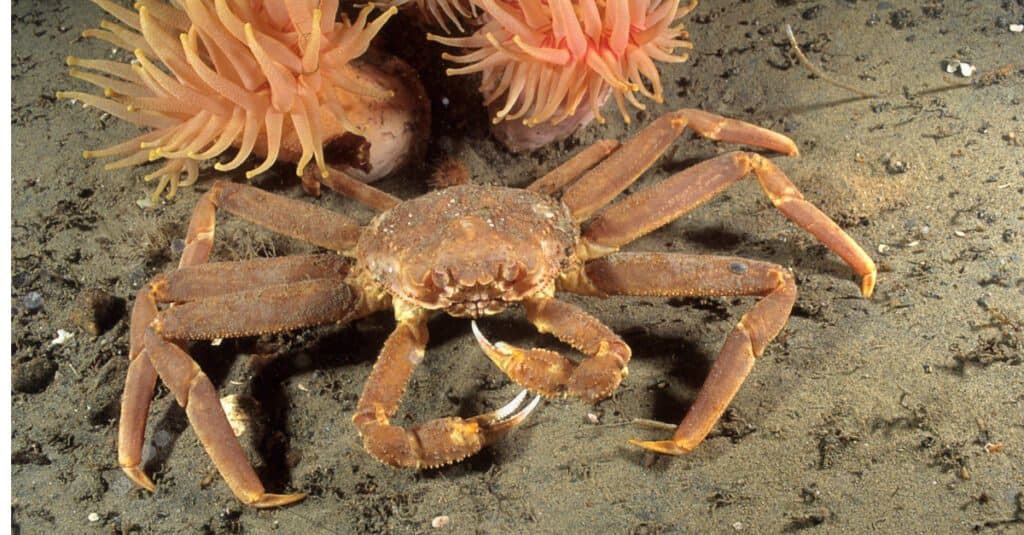
Opilio crabs are found in the northwest Atlantic and North Pacific
©RLS Photo/Shutterstock.com
The opilio crab (Chionoecetes opilio) is a species of snow crab, also known as opies. They live in the northwest Atlantic Ocean and the North Pacific Ocean. Male crabs are larger than females and can grow up to 6.5 inches and will weigh up to 3 pounds. These crabs are found at depths of 43 to 7,175 feet.
The opilio crab eats small invertebrates and scavenges on the seabed. They usually live for 5 to 6 years and mate before they die. Snow crabs are caught near Alaska and Canada, then are sold across the world.
#7: Dungeness Crab
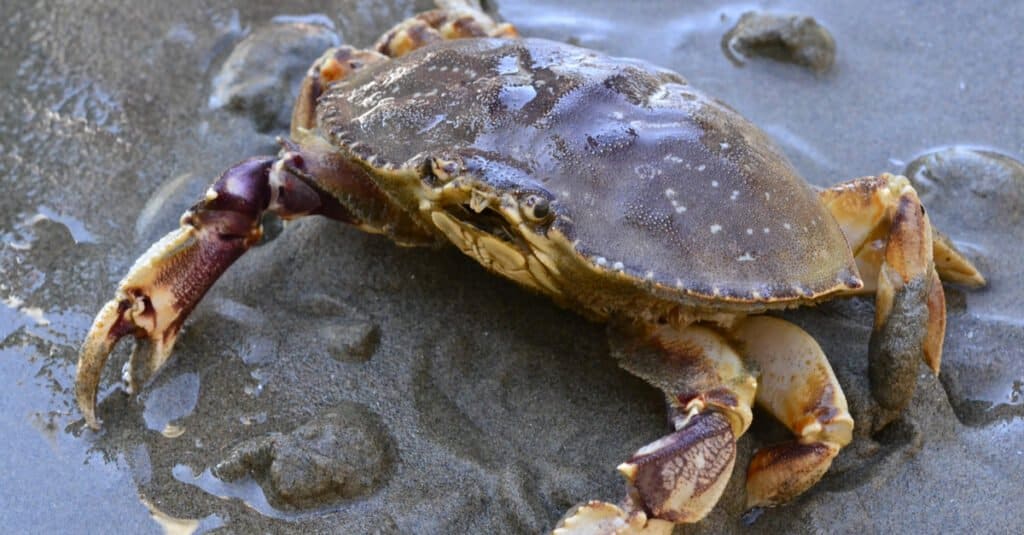
Dungeness crabs are renowned for the quality of their meat
©Jennifer Nicole Buchanan/Shutterstock.com
The Dungeness crab (Metacarcinus magister) is found in the west coast oceans of North America. On average they reach around 7.9 inches but large ones may reach up to 9.8 inches. This crab is the most fished species in the Pacific Northwest. These crabs are especially plentiful above 150 feet and can be found at depths of up to 750 feet.
The Dungeness crab is more expensive compared to other crabs because of the quality of its meat. They periodically molt their shell in the fall before mating occurs. Males get attracted to females by the pheromones in their urine.
#6: Brown Crab

Brown crabs are nocturnal and conceal themselves beneath rocks and debris
©Charlotte Bleijenberg/Shutterstock.com
Brown crabs (Cancer pagurus) are also called edible crabs. Females are larger than males and can grow up to 6 inches but in the right habitat, they can reach 10 inches. They are found in the northeast Atlantic waters and can reach waters near Norway and Africa. They live at depths of up to 330ft.
Brown crabs inhabit holes, hide under rocks and other debris. They are nocturnal and come out to feed at night. During the day they bury themselves but never sleep. They stay awake and watch for enemies. Octopuses are their main predators although they are fished and frequently farmed.
#5: Red King Crab
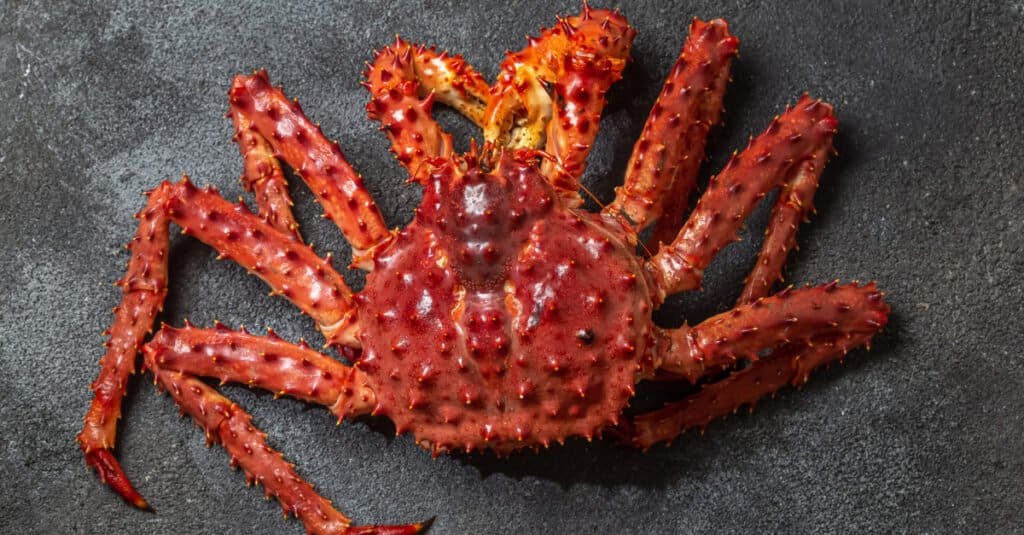
The red king crab is endemic to the Bering Sea and the region around the Kamchatka Peninsula
©Larisa Blinova/Shutterstock.com
The red king crab (Paralithodes camtschaticus) is also named the Kamchatka crab and the Alaskan King Crab. The red king crab is the largest species of king crab with a carapace of 7 inches and a mass of 6 lbs. They are capable of having their carapace reach 11 inches and can weigh as much as 28 lbs although it is rare. Red king crabs are named after the color they turn when cooked but can be brownish to blueish red and are covered in sharp spikes.
Red king crabs are endemic to the Bering Sea, the North Pacific Ocean, and the waters near the Kamchatka Peninsula. In the minds of many, this species is the prime choice of crab and is harvested across the oceans they live in. They have been steadily declining in the wild. Overfishing, a large number of predators, and global warming are believed to be probable causes.
#4: Giant Mud Crab

The giant mud crab is omnivorous and feeds on other crustaceans, fish, mollusks, and vegetation
©Jocelyn Watts/Shutterstock.com
The giant mud crab (Scylla serrata) is also known as the Mangrove crab, black crab, serrated swimming crab, and the Indo-Pacific mud crab. The average carapace of this species is 9 inches but they can get as large as 11 inches and up to 11 lbs. They are found in estuaries and mangroves across the Indo-Pacific.
Mud crabs range from green to black and have spikes on the edge of their carapace. Mollusks and crustaceans are their main source of food but they will also eat plants and fish. Female mud crabs will bury themselves in the mud and males seek shelter in a burrow. In cold temperatures, they begin to become inactive.
#3: Coconut Crab
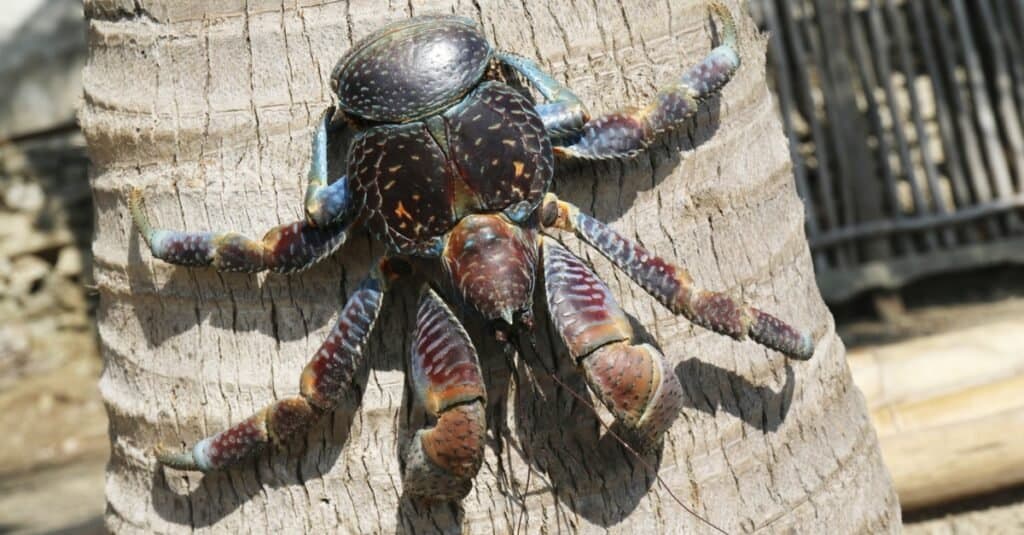
The coconut crab has the strongest claws found on any terrestrial crustacean
©KYTan/Shutterstock.com
Coconut crabs (Birgus latro), also called robber crabs are the largest terrestrial crabs. They can grow up to 3 ft 3 in and weigh 9 lbs. In areas with human populations, their presence has been extirpated but they are found on islands across the Indian and Pacific Oceans. The coconut crab is unable to swim and spends most of its life on land.
The coconut crabs’ closest relative is the hermit crab, but they have evolved to be gigantic. They have the strongest claws of all land-dwelling crustaceans and can produce up to 3300 Newtons of force. As larvae, they live in the sea for around a month and then travel onto land. Young coconut crabs will live in snail shells until they grow too large. When large enough they will take shelter in underground burrows next to coconut trees. They have a long life span of over 60 years and survive off small animals, fruits, nuts vegetation, and carrion.
#2: Tasmanian Giant Crab

©Emőke Dénes, CC BY-SA 4.0 <https://creativecommons.org/licenses/by-sa/4.0>, via Wikimedia Commons – Original / License
The Tasmanian Giant Crab (Pseudocarcinus genus) is one of the largest crabs in the world with a carapace width of up to 18 inches and a mass of up to 39 pounds. This giant lives in muddy bottoms off in the Southern Australian Ocean on the edge of the continental shelf. They are most common at depths of 560 to 590 ft in the summer and will travel deeper into the water in the winter at a depth of 620 to 1,310 ft.
The Tasmanian giant crab eats smaller slow-moving species like gastropods, crustaceans, and starfish. They will also feed on carrion which is the dead and decaying flesh of past life. Male Tasmania crabs reach twice the size of females. The average for males is over 30 lbs and the female average is 15 lbs. Males can reach up to 39 lbs and have one oversized claw. The top of their carapace is red with a yellow or light-colored belly.
#1: Japanese Spider Crab

The Japanese spider crab relies on algae and sponges to conceal itself from predators
©Tsarli at en.wikipedia / Creative Commons – Original
The Japanese spider crab is the largest crab in the world. Living near Japan, the Japanese spider crab (Macrocheira kaempferi) has the longest legs of any arthropod. It is possible for the distances between their claws to measure up to 12 ft. They have a carapace width of 16 inches and can weigh up to 42 lbs. Around the Japanese islands of Honshu, to Tokyo bay, this gentle giant can be found at depths of 160 to 1,970 feet.
Pearl-shaped with a narrow head, the Japanese spider crab is orange and covered in dark spots. To avoid predators they will use algae and sponges to camouflage better in the ocean. Large fish and octopus are their most common predators along with humans. Measures have been taken to ensure the population of this species does not decline from overfishing. A diet of decaying matter on the seafloor helps this species live up to 100 years.
Summary Of The 10 Largest Crabs In The World
| Rank | Crab | Size | Found In |
|---|---|---|---|
| 10 | Florida Stone Crab | Carapace is 5 to 6.5 inches but claws can reach up to 5 inches | Western North Atlantic |
| 9 | Blue Crab | Can reach up to 9 inches but weigh 1 lb | Atlantic Ocean and the Gulf of Mexico |
| 8 | Opilio Crab | Can grow up to 6.5 inches and will weigh up to 3 pounds | Northwest Atlantic Ocean and North Pacific Ocean |
| 7 | Dungeness Crab | Reach around 7.9 inches but large ones may reach up to 9.8 inches | West Coast Oceans of North America |
| 6 | Brown Crab | Can grow up to 6 inches but in the right habitat, they can reach 10 inches | Northeast Atlantic waters, but can reach Norway and Africa |
| 5 | King Crab | Carapace of 7 inches & a mass of 6 lbs Capable of having carapaces reach 11 inches & can weigh as much as 28 lbs | Bering Sea, the North Pacific Ocean, and near the Kamchatka Peninsula |
| 4 | Giant Mud Crab | Carapace is 9 inches but they can get as large as 11 inches and up to 11 lbs | Indo-Pacific |
| 3 | Coconut Crab | Can grow up to 3 ft 3 in & weigh 9 lbs | Indian and Pacific Oceans |
| 2 | Tasmanian Giant Crab | Carapace of up to 18 inches and a mass of up to 39 pounds | South Australian Ocean |
| 1 | Japanese Spider Crab | Carapace of 16 inches and can weigh up to 42 lbs | Japan |
Are Alaskan Snow Crabs Disappearing?

The Alaskan snow crab population in the Bering Sea took a major hit in the last five years, declining from 12 billion to less than 2 billion due to climate change.
©chuck hsu/Shutterstock.com
While Alaskan snow crabs may not be the largest kids on the block, they are an important species to the fishing industry in the United States. They are in fact one of the most popular types of crabs consumed in the U.S. However, the Alaskan snow crab population went into a tailspin in recent years when it was discovered that their numbers had shrunk from 12 billion to a little under 2 billion. While you might imagine this occurred because of overfishing, that’s actually not the case. The culprit researchers are blaming is climate change.
The decline, which took place between 2018 and 2022, is believed to have occurred due to warmer ocean temperatures. Alaskan snow crabs thrive in very cold water. In recent years, ice has decreased. An ice covering in winter keeps the waters very cold, while its melting in warmer months creates cold pools for young crabs to feed in. With warmer temperatures, snow crabs can die from starvation as these cold pools shrink, causing them to have to compete over fewer resources. Warmer water can also cause them to contract diseases, which may also contribute to the die-off.
The snow crab season was canceled in 2022 once news of the huge disappearance of billions of snow crabs was discovered, which negatively impacted those fishing companies that rely on catching snow crabs for their livelihood. This year (2023) saw the Alaska Department of Fish and Game close the Alaskan snow crab fishing season again, and it will also be closed in 2024. Hopefully, these animals can recover from this epic loss of life.
The photo featured at the top of this post is © Charlotte Bleijenberg/Shutterstock.com
Thank you for reading! Have some feedback for us? Contact the AZ Animals editorial team.







